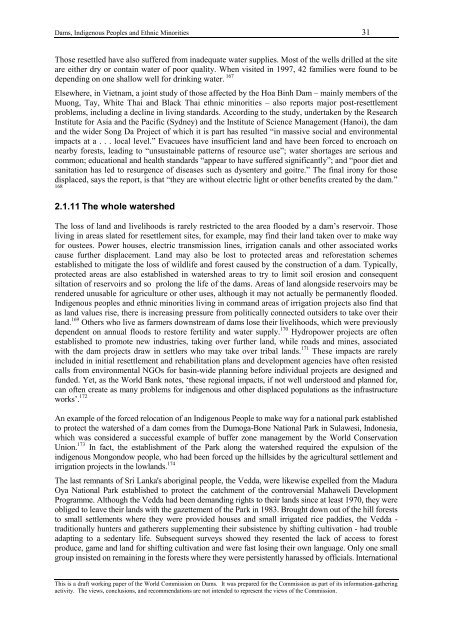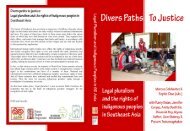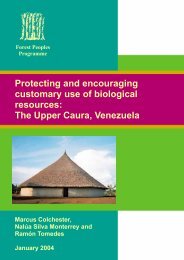Thematic Review II.2: Dams, Indigenous Peoples and Ethnic Minorities
Thematic Review II.2: Dams, Indigenous Peoples and Ethnic Minorities
Thematic Review II.2: Dams, Indigenous Peoples and Ethnic Minorities
Create successful ePaper yourself
Turn your PDF publications into a flip-book with our unique Google optimized e-Paper software.
<strong>Dams</strong>, <strong>Indigenous</strong> <strong>Peoples</strong> <strong>and</strong> <strong>Ethnic</strong> <strong>Minorities</strong> 31<br />
Those resettled have also suffered from inadequate water supplies. Most of the wells drilled at the site<br />
are either dry or contain water of poor quality. When visited in 1997, 42 families were found to be<br />
depending on one shallow well for drinking water. 167<br />
Elsewhere, in Vietnam, a joint study of those affected by the Hoa Binh Dam – mainly members of the<br />
Muong, Tay, White Thai <strong>and</strong> Black Thai ethnic minorities – also reports major post-resettlement<br />
problems, including a decline in living st<strong>and</strong>ards. According to the study, undertaken by the Research<br />
Institute for Asia <strong>and</strong> the Pacific (Sydney) <strong>and</strong> the Institute of Science Management (Hanoi), the dam<br />
<strong>and</strong> the wider Song Da Project of which it is part has resulted “in massive social <strong>and</strong> environmental<br />
impacts at a . . . local level.” Evacuees have insufficient l<strong>and</strong> <strong>and</strong> have been forced to encroach on<br />
nearby forests, leading to “unsustainable patterns of resource use”; water shortages are serious <strong>and</strong><br />
common; educational <strong>and</strong> health st<strong>and</strong>ards “appear to have suffered significantly”; <strong>and</strong> “poor diet <strong>and</strong><br />
sanitation has led to resurgence of diseases such as dysentery <strong>and</strong> goitre.” The final irony for those<br />
displaced, says the report, is that “they are without electric light or other benefits created by the dam.”<br />
168<br />
2.1.11 The whole watershed<br />
The loss of l<strong>and</strong> <strong>and</strong> livelihoods is rarely restricted to the area flooded by a dam’s reservoir. Those<br />
living in areas slated for resettlement sites, for example, may find their l<strong>and</strong> taken over to make way<br />
for oustees. Power houses, electric transmission lines, irrigation canals <strong>and</strong> other associated works<br />
cause further displacement. L<strong>and</strong> may also be lost to protected areas <strong>and</strong> reforestation schemes<br />
established to mitigate the loss of wildlife <strong>and</strong> forest caused by the construction of a dam. Typically,<br />
protected areas are also established in watershed areas to try to limit soil erosion <strong>and</strong> consequent<br />
siltation of reservoirs <strong>and</strong> so prolong the life of the dams. Areas of l<strong>and</strong> alongside reservoirs may be<br />
rendered unusable for agriculture or other uses, although it may not actually be permanently flooded.<br />
<strong>Indigenous</strong> peoples <strong>and</strong> ethnic minorities living in comm<strong>and</strong> areas of irrigation projects also find that<br />
as l<strong>and</strong> values rise, there is increasing pressure from politically connected outsiders to take over their<br />
l<strong>and</strong>. 169 Others who live as farmers downstream of dams lose their livelihoods, which were previously<br />
dependent on annual floods to restore fertility <strong>and</strong> water supply. 170 Hydropower projects are often<br />
established to promote new industries, taking over further l<strong>and</strong>, while roads <strong>and</strong> mines, associated<br />
with the dam projects draw in settlers who may take over tribal l<strong>and</strong>s. 171 These impacts are rarely<br />
included in initial resettlement <strong>and</strong> rehabilitation plans <strong>and</strong> development agencies have often resisted<br />
calls from environmental NGOs for basin-wide planning before individual projects are designed <strong>and</strong><br />
funded. Yet, as the World Bank notes, ‘these regional impacts, if not well understood <strong>and</strong> planned for,<br />
can often create as many problems for indigenous <strong>and</strong> other displaced populations as the infrastructure<br />
works’. 172<br />
An example of the forced relocation of an <strong>Indigenous</strong> People to make way for a national park established<br />
to protect the watershed of a dam comes from the Dumoga-Bone National Park in Sulawesi, Indonesia,<br />
which was considered a successful example of buffer zone management by the World Conservation<br />
Union. 173 In fact, the establishment of the Park along the watershed required the expulsion of the<br />
indigenous Mongondow people, who had been forced up the hillsides by the agricultural settlement <strong>and</strong><br />
irrigation projects in the lowl<strong>and</strong>s. 174<br />
The last remnants of Sri Lanka's aboriginal people, the Vedda, were likewise expelled from the Madura<br />
Oya National Park established to protect the catchment of the controversial Mahaweli Development<br />
Programme. Although the Vedda had been dem<strong>and</strong>ing rights to their l<strong>and</strong>s since at least 1970, they were<br />
obliged to leave their l<strong>and</strong>s with the gazettement of the Park in 1983. Brought down out of the hill forests<br />
to small settlements where they were provided houses <strong>and</strong> small irrigated rice paddies, the Vedda -<br />
traditionally hunters <strong>and</strong> gatherers supplementing their subsistence by shifting cultivation - had trouble<br />
adapting to a sedentary life. Subsequent surveys showed they resented the lack of access to forest<br />
produce, game <strong>and</strong> l<strong>and</strong> for shifting cultivation <strong>and</strong> were fast losing their own language. Only one small<br />
group insisted on remaining in the forests where they were persistently harassed by officials. International<br />
This is a draft working paper of the World Commission on <strong>Dams</strong>. It was prepared for the Commission as part of its information-gathering<br />
activity. The views, conclusions, <strong>and</strong> recommendations are not intended to represent the views of the Commission.

















